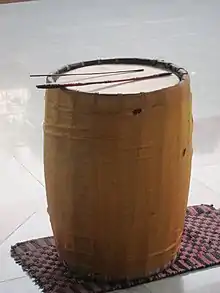
The dhak is a huge membranophone instrument from Bengal and Assam.[1] The shapes differ from the almost cylindrical to the barrel. The manner of stretching the hide over the mouths and lacing also varies. It suspended from the neck, tied to the waist and kept on the lap or the ground, and usually played with wooden sticks. The left side is coated to give it a heavier sound.[2]
It is of medieval origin,[3] and is used in Hindu religious festivals of the region, especially of Sakta and Shaiva traditions, including Durga Puja, Kali Puja and Charak Puja.[1][4]
The drum beats, mostly played by the Bengali Hindu community, alongwith the arati (invocation dance) forms an integral part of Durga Puja unique to Bengal.[3][4][5] The tea-tribes of Assam play dhak along with nagara.[1]
The Statesman wrote, "Durga Puja does not assume the festive aura without the maddening beats of the dhak, the large drum that people hang around their necks and play with two thin sticks to infuse the frenzied rhythm into listeners. Those enchanting beats are enough to conjure up the sights and smells of Durga Puja."[6]
 Bengali drummers during Manasa Puja in Birbhum, West Bengal
Bengali drummers during Manasa Puja in Birbhum, West Bengal Bengal drummer and a dhaki
Bengal drummer and a dhaki A dhaki with his magnificent dhak at a South Kolkata Durga Puja pandal, 2010.
A dhaki with his magnificent dhak at a South Kolkata Durga Puja pandal, 2010. Dhak players, Sealdah, Kolkata
Dhak players, Sealdah, Kolkata Dhak players Sealdah, Kolkata
Dhak players Sealdah, Kolkata
See also
References
- 1 2 3 Barthakur, Dilip Ranjan (2003). The Music and Musical Instruments of North Eastern India. Mittal Publications. p. 97. ISBN 978-81-7099-881-5.
- ↑ "Instruments". Percussions. beatofindia.com. Retrieved 13 January 2008.
- 1 2 Kuppuswamy, Gowri; Hariharan, Muthuswamy (1980). Indian Music: A Perspective. Sundeep Prakashan. p. 152. ISBN 978-0-8364-0629-0.
- 1 2 Folk-lore. Indian Publications. 1975. pp. 429, 430.
- ↑ "Traditions of Durga Puja". Society for confluence of festivals in India. Retrieved 13 January 2008.
- ↑ Bhattachatya, Kajari (26 September 2006). "Beats of changing time". The Statesman. Kolkata.